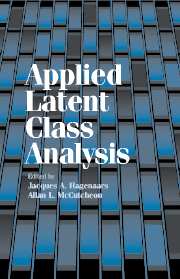Book contents
- Frontmatter
- Contents
- Contributors
- Preface
- INTRODUCTION
- CLASSIFICATION AND MEASUREMENT
- CAUSAL ANALYSIS AND DYNAMIC MODELS
- UNOBSERVED HETEROGENEITY AND NONRESPONSE
- 12 A Latent Class Approach to Measuring the Fit of a Statistical Model
- 13 Mixture Regression Models
- 14 A General Latent Class Approach to Unobserved Heterogeneity in the Analysis of Event History Data
- 15 Latent Class Models for Contingency Tables with Missing Data
- Appendix A: Notational Conventions
- Appendix B: Further Readings
- Appendix C: Selected Software; Webpage
- Index
15 - Latent Class Models for Contingency Tables with Missing Data
Published online by Cambridge University Press: 31 July 2009
- Frontmatter
- Contents
- Contributors
- Preface
- INTRODUCTION
- CLASSIFICATION AND MEASUREMENT
- CAUSAL ANALYSIS AND DYNAMIC MODELS
- UNOBSERVED HETEROGENEITY AND NONRESPONSE
- 12 A Latent Class Approach to Measuring the Fit of a Statistical Model
- 13 Mixture Regression Models
- 14 A General Latent Class Approach to Unobserved Heterogeneity in the Analysis of Event History Data
- 15 Latent Class Models for Contingency Tables with Missing Data
- Appendix A: Notational Conventions
- Appendix B: Further Readings
- Appendix C: Selected Software; Webpage
- Index
Summary
INTRODUCTION
Missing data is a common problem in many types of data analysis. In this paper, we show how to deal with missing data in loglinear analyses of frequency tables. Our approach is based on two ideas: (1) Latent class models can be adapted to contingency tables with missing data by defining variables that are latent (missing) for some cases and are manifest (observed) for others; and (2) latent class models can be viewed as loglinear models for tables in which some cells are unobserved or partially observed. Using our approach, we can retain the loglinear model framework and notation and deal with missing data through a modest extension of the standard model. Flexible software for latent class models, such as DNEWTON (Haberman, 1989) and LEM (Vermunt, 1996) is required, but the conceptual extension of elementary loglinear models is straightforward.
By explicitly incorporating missing data into the analysis of a contingency table, one can address two concerns. First, a researcher may be worried about the possible loss of statistical power or precision of estimation that results when observations with missing data are excluded from an analysis. If many cases have missing data on at least one variable, exclusion of these cases from the analysis may substantially reduce the sample and create unacceptably large standard errors. One may want to incorporate cases with missing data into the analysis so that the information associated with these cases can be used to obtain more precise estimates.
Information
- Type
- Chapter
- Information
- Applied Latent Class Analysis , pp. 408 - 432Publisher: Cambridge University PressPrint publication year: 2002
Accessibility standard: Unknown
Why this information is here
This section outlines the accessibility features of this content - including support for screen readers, full keyboard navigation and high-contrast display options. This may not be relevant for you.Accessibility Information
- 4
- Cited by
